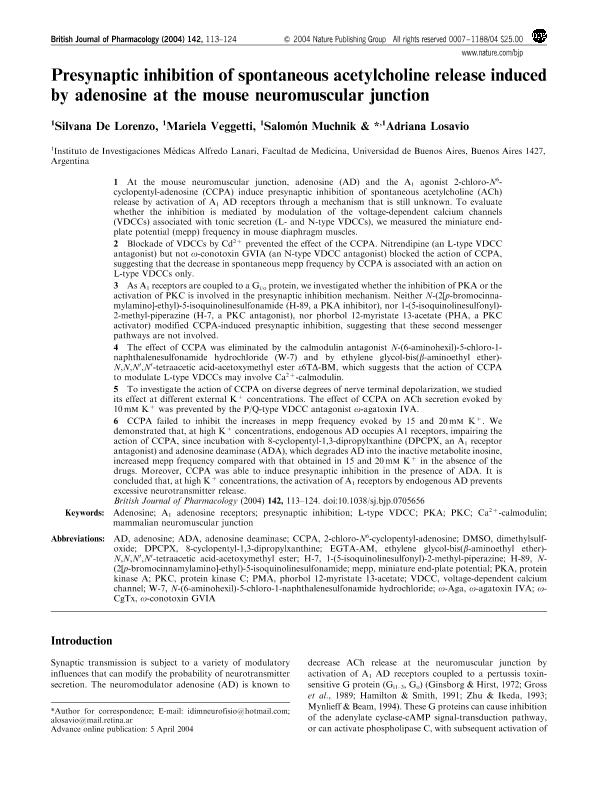Artículo
Presynaptic inhibition of spontaneous acetylcholine release induced by adenosine at the mouse neuromuscular junction
Fecha de publicación:
05/2004
Editorial:
Wiley Blackwell Publishing, Inc
Revista:
British Journal of Pharmacology
ISSN:
0007-1188
Idioma:
Inglés
Tipo de recurso:
Artículo publicado
Clasificación temática:
Resumen
1 At the mouse neuromuscular junction, adenosine (AD) and the A1 agonist 2-chloro-N6-cyclopentyl-adenosine (CCPA) induce presynaptic inhibition of spontaneous acetylcholine (ACh)release by activation of A1 AD receptors through a mechanism that is still unknown. To evaluatewhether the inhibition is mediated by modulation of the voltage-dependent calcium channels(VDCCs) associated with tonic secretion (L- and N-type VDCCs), we measured the miniature endplatepotential (mepp) frequency in mouse diaphragm muscles.2 Blockade of VDCCs by Cd2þ prevented the effect of the CCPA. Nitrendipine (an L-type VDCCantagonist) but not o-conotoxin GVIA (an N-type VDCC antagonist) blocked the action of CCPA,suggesting that the decrease in spontaneous mepp frequency by CCPA is associated with an action onL-type VDCCs only.3 As A1 receptors are coupled to a Gi/o protein, we investigated whether the inhibition of PKA or theactivation of PKC is involved in the presynaptic inhibition mechanism. Neither N-(2[p-bromocinnamylamino]-ethyl)-5-isoquinolinesulfonamide (H-89, a PKA inhibitor), nor 1-(5-isoquinolinesulfonyl)-2-methyl-piperazine (H-7, a PKC antagonist), nor phorbol 12-myristate 13-acetate (PHA, a PKCactivator) modified CCPA-induced presynaptic inhibition, suggesting that these second messengerpathways are not involved.4 The effect of CCPA was eliminated by the calmodulin antagonist N-(6-aminohexil)-5-chloro-1-naphthalenesulfonamide hydrochloride (W-7) and by ethylene glycol-bis(b-aminoethyl ether)-N,N,N0,N0-tetraacetic acid-acetoxymethyl ester e6TD-BM, which suggests that the action of CCPAto modulate L-type VDCCs may involve Ca2þ-calmodulin.5 To investigate the action of CCPA on diverse degrees of nerve terminal depolarization, we studiedits effect at different external Kþ concentrations. The effect of CCPA on ACh secretion evoked by10mM Kþ was prevented by the P/Q-type VDCC antagonist o-agatoxin IVA.6 CCPA failed to inhibit the increases in mepp frequency evoked by 15 and 20mM Kþ. Wedemonstrated that, at high Kþ concentrations, endogenous AD occupies A1 receptors, impairing theaction of CCPA, since incubation with 8-cyclopentyl-1,3-dipropylxanthine (DPCPX, an A1 receptorantagonist) and adenosine deaminase (ADA), which degrades AD into the inactive metabolite inosine,increased mepp frequency compared with that obtained in 15 and 20mM Kþ in the absence of thedrugs. Moreover, CCPA was able to induce presynaptic inhibition in the presence of ADA. It isconcluded that, at high Kþ concentrations, the activation of A1 receptors by endogenous AD preventsexcessive neurotransmitter release.
Archivos asociados
Licencia
Identificadores
Colecciones
Articulos(IDIM)
Articulos de INST.DE INVEST.MEDICAS
Articulos de INST.DE INVEST.MEDICAS
Articulos(OCA HOUSSAY)
Articulos de OFICINA DE COORDINACION ADMINISTRATIVA HOUSSAY
Articulos de OFICINA DE COORDINACION ADMINISTRATIVA HOUSSAY
Citación
de Lorenzo, Silvana; Veggetti, Mariela Iris; Muchnik, Salomon; Losavio, Adriana Silvia; Presynaptic inhibition of spontaneous acetylcholine release induced by adenosine at the mouse neuromuscular junction; Wiley Blackwell Publishing, Inc; British Journal of Pharmacology; 142; 1; 5-2004; 113-124
Compartir
Altmétricas




